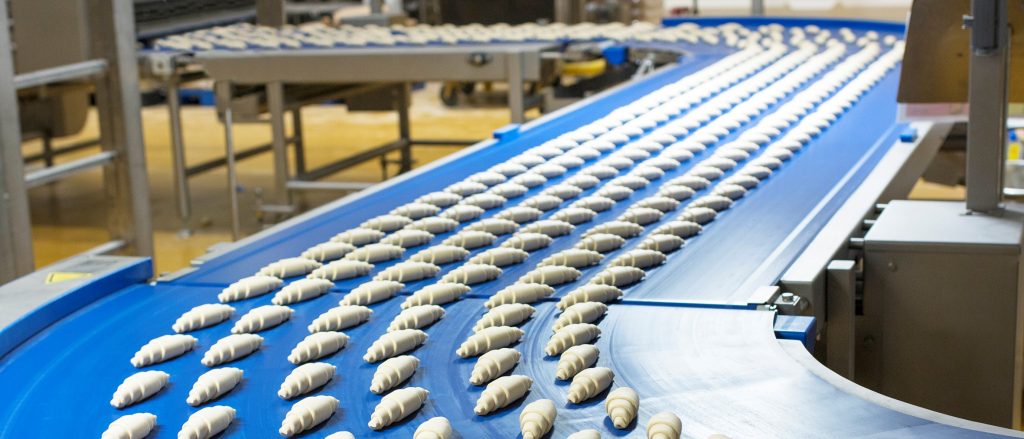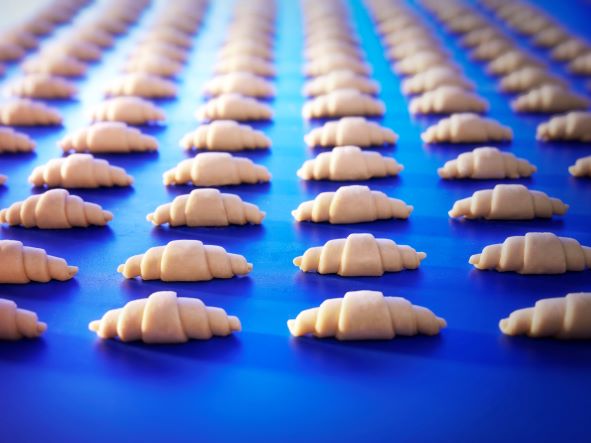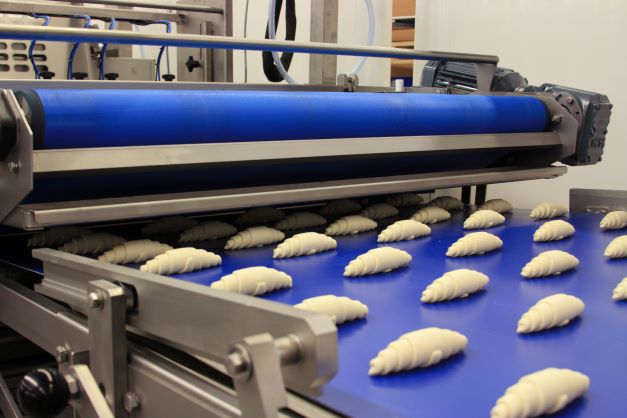Croissants continue to gain popularity worldwide. Every region of the world has its own croissant products and therefore unique characteristics. In some parts of the World, the Middle East and Asian region in particular, demand long shelf life products. This is the reason why the long shelf life croissants were developed. Croissant production lines were among the very first Rademaker bakery production lines produced and we are proud to be the global leader in Croissant production lines. With our three decades of experience, Rademaker is able to produce long shelf life croissant types that meet our client’s demands.
When it comes down to long shelf life croissant production lines, the first important question that arises is how long the desired shelf life should be. Shelf life can range from 7 days to 6 months. This shelf life will determine the recipe but also the procedure of dough development. The way the croissant is cooled and packed too, is of great influence to the shelf life of the product.
According to the Rademaker long shelf life technology, four drives determine the quality and the shelf life of the croissant.
- Recipe
The recipe for long shelf life croissants is unique. Long lasting softness is created by making use of mother dough and rich recipe with margarine, sugar, eggs, glucose syrup and a special blend of enzymes. The enzymes blend can be used in combination with a bread improver to contribute tolerance and volume.
The combination of these ingredients, in its specific mixture, will reduce the amount of free water inside of the dough (aW).
In hot, humid countries, or in case of a desired long shelf life, calcium-propionate (cp) as preservative is used to a maximum of 0,3% flour weight. The odor of cp is normally regarded as unpleasant, while as natural preservatives (developed during fermentation and by using mother dough) it is regarded as pleasant but less effective.
Another crucial aspect for the keep-ability of these products is the filling. Important is to use fillings that are in balance with the baked croissant crumb; if the filling is too hygroscopic it will attract all water from the crumb. If the filling will release water, the result will be soaked, patchy crumb with dried filling.
Last aspect, the choice for margarine (or shortening, fat, etc.) or butter is important as well. Butter is much more vulnerable for rancidity than vegetable fats.
- Process/Procedure
Long shelf life croissants are produced with very long fermentation times. This differs from the process for ‘normal’ croissants. The long fermentation times arise because mother dough is used (also called levains, brews, preferments, sauerteig, etc.) in combination with the usage of a very low free water amount and the very high amount of fat and sugar is used in the dough. A maximum of flavor development and sometimes usages of preservatives, like calcium propionate, also contribute to this long fermentation times. However, the mother doughs procedure contribute to this the most.
The mother dough procedure starts with a small amount of culture or strain. This culture is created spontaneous by air fermentation or by purchased strain. Accordingly, this strain is up scaled by flour, water and temperature. This scaling can be done in several fermentation steps. Whether the choice is made for one, two or three fermentation steps is depending on recipe costs, desired quality, pH, production equipment and dough handling. Important is the development of the strain called ‘Saccharomyces Exiguous’. This strain will decrease the acidity of the dough and creates a natural preservative.



To upscale the strain and to keep the characteristics of the strain vivid, there are two basic ways:
1. One-time purchase.
A certain amount of strain/culture can be used as a starter for the next day. Whether the mother dough’s strain/culture remains stable and daily performs the same, depends on the bakery conditions.
2. Repeatedly purchase.
Every day a fresh batch is started up for croissants production. This method may be a bit more expensive but the predictability of the production process, especially the final proofing time, is much more reliable.
Mother dough is necessary to, besides taste and crumb softness development, lower the pH of the dough. By doing so, natural preservatives (various types of lactic acid, citric acid, etc.) are created. During the fermentation of the mother dough, the pH will decrease to levels of < 4. After mixing and final proofing, the pH can reach 4,5 to 5.
- Dough equipment – Dough shaping
Rademaker offers Croissant production lines to produce long shelf life croissants. Capacities starting at 800 kg up to over 2,000 kg per hour leading to a product quantity of 12,000 pieces an hour up to 70,000 pieces per hour. Capacities depend on the size and weight of the croissants.
The Rademaker Sigma Laminator will provide the correct laminated dough sheet. This dough sheet is fed towards the Rademaker Croissant production line. Because of the Low Stress Sheeter it is possible to handle doughs that require the long fermentation times that are required for long shelf life croissants.
- Proofing, Baking, Packaging – Handling
The final proofing time of the croissants is very long. This is due to the usage of mother dough, the rich recipe, the usage of preservative and the very limited amount of water. Depending on the recipe, we have seen final proofing times from 180 minutes to bakeries with over 300 minutes.
To avoid drying of the product and to keep the maximum of moisture inside of the product, the product should be baked with limited convection and maximum radiation and conduction. Baking time depends heavily on the size of the product. For example for a 65-gram product, the baking time is approximately 11 minutes.
A very important aspect that also determines the shelf life and product quality is the final step in the production process: packaging. Assuming that the croissant is packed in flow-pack (horizontal) or trans wrap (vertical) packaging, there is the possibility to increase shelf life by making use of gas flushing: a mixture of Nitrogen 40% – 0% and Carbon dioxide 60% – 100%. For this procedure, it is necessary to use special equipment and special foil.
Summary of long shelf life croissant preservation
Basically there are three ways of preserving the product:
- In the dough. By lowering pH by long fermentation/ mother dough technology or by adding calcium propionate. In addition, the filling can contain preservatives that has effect on croissant crumb.
- Special crust treatment.
- Around the croissant by gas flush during the wrapping process.
The long shelf life technology expertise is carefully applied in Rademaker’s Croissant lines and production solutions. As the global leader in Croissant production lines Rademaker can assure that the Croissant Production line will deliver the taste, texture, shape, and capacity that you and your customers expect.

